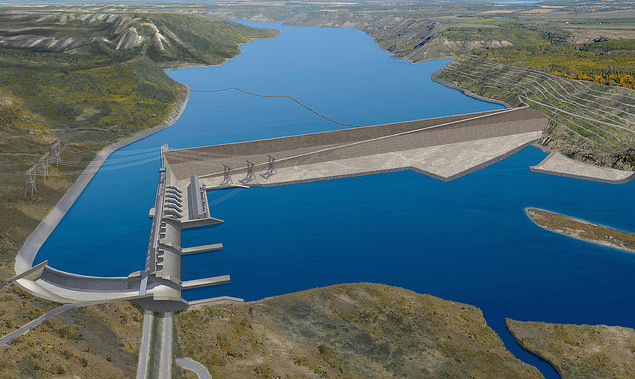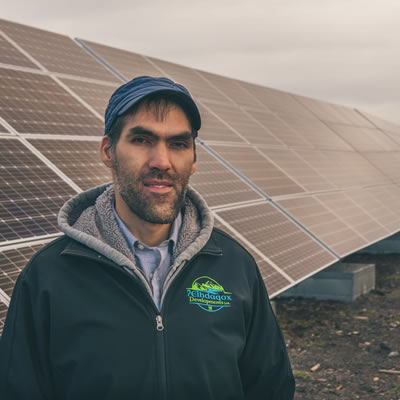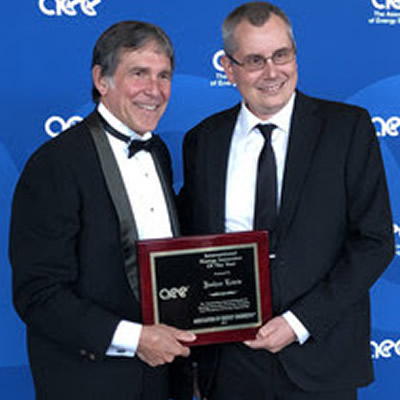Site C dam project to break ground this summer
Construction of the dam is expected to take an additional nine years

Artist rendering of the Site C dam — Image courtesy BC Hydro
After 11 years of consultations, evaluations, negotiations and project planning work, BC Hydro’s Site C dam project on the Peace River in northeastern British Columbia will finally begin construction this July.
Despite this lengthy development process, the project is still just a little over halfway toward completion. Construction of the dam is expected to take an additional nine years, with the turbines finally beginning to produce power in 2024. And even that date might be optimistic. Despite receiving federal and provincial certifications in late 2014, BC Hydro is still seeking a number of land and water use permits and authorizations, and it is facing legal action from seven groups at both provincial and federal levels. Concerns raised in the lawsuits range from the project’s environmental impact to questions about whether another hydro project is the most economical way to produce electricity.
Despite these hurdles, Dave Conway, community relations manager for the Site C dam, said BC Hydro is forging ahead. “What we are doing is looking at areas where we already have permits or don’t need them, such as BC Hydro-owned lands, and starting work there.”
Even though BC Hydro is eager to break ground, at least one group opposed to the dam, the Peace Valley Landowners Association, is recommending it be delayed by two years. According to a report they commissioned from renowned energy economist Robert McCullough, not only would the delay allow the Crown corporation to explore potentially lower cost and more environmentally friendly power-generation alternatives, such as wind, solar and geothermal, it could also save taxpayers up to $200 million. These savings would come from eliminating the need for BC Hydro to sell excess electricity at a loss prior to when Site C’s full 5,100-gigawatt capacity is required.
However, Conway points out that McCullough’s numbers don’t square with independent assessments from Synapse Energy Economics or the accounting firm KPMG, which were part of Site C’s joint-review process. In fact, he argued that rather than save money, any delays could push the dam’s $8.3 billion dollar price tag even higher due to demobilizing and remobilizing costs as well as inevitable interest rate hikes. It would also mean forestalling the thousands of jobs the project will create.
“Current economic conditions are actually ideal for building a large infrastructure project like Site C,” Conway said. “We have a slowdown in related industries, such as coal, due to low commodity prices. That means we have lots of skilled people available who can begin working on this project. This is an earth fill dam, and a lot of the work involves moving materials. The people who know how to do that are available now. That’s why we are looking to start this project in July.”
In addition to potentially driving up construction costs, delays would also force BC Hydro to purchase electricity on the market, which is more expensive than generating it on its own. When complete, the Site C dam will generate enough electricity to power 450,000 homes each year. Therefore, Conway said the sooner BC Hydro can begin generating that power, the better.
“The dam does not solve all of BC Hydro’s energy capacity needs, but it helps,” he said.
Although the project will require flooding an estimated 5,500 hectares of land—including over 3,000 hectares of wildlife habitat, heritage sites and agricultural areas—Conway said the project doesn’t just make economic sense, it’s also the best option for the environment.
“As a province, our electricity is already 93 per cent renewable, when you consider hydro, micro-hydro, wind and biomass plants," he said. "The Site C project can deliver power to ratepayers at a considerably lower rate than wind and run-of-river hydro and with lower greenhouse gas emissions than natural gas, coal and geothermal.”
Despite BC Hydro’s determination to move ahead, Conway insists that consultation with everyone affected by the dam will be an ongoing process. “Because we are a Crown company, we represent the Crown and the honour of the Crown, which means we have the duty to consult and, where appropriate, accommodate local communities. We know the project will have impacts. We have been consulting with the public since 2007 and will continue to do so in the future to the best of our ability.”




